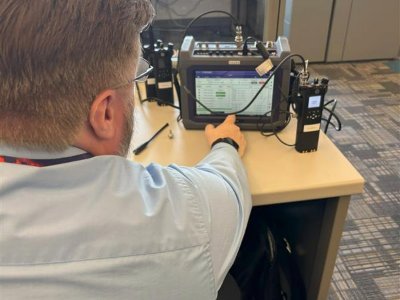Advanced Device Recalibrates Radios for Crystal-Clear Sound and Longer Lifespan
August 06, 2025 By: Taylor Thornton

Subtly yet steadily over time, the radios carried by our police officers and public safety officers deteriorate. While wear and tear is visible on the surface, inside the device one component is critical to police services.
And with the acquisition of a new tool, radios can now be renewed to improve clarity and reduce downtime by realigning internal electronics to the right frequencies.
About the same size as an Automated External Defibrillator – but much heavier – the division’s Communication Service Monitor, known to the team as the CX300, allows the division to recalibrate and test its public safety radios in-house.
“Cost-efficiency was a key factor in our decision [to purchase CX300],” said Threat and Risk Analyst Eric Thacker, who oversees the new system. “Once we saw how user-friendly the device was, it became clear that bringing the capability in-house was the smarter, more sustainable choice.”
The CX300 not only calibrates radios. When the device is brought to different buildings and work areas, it can assess signal quality, check transmission clarity, and tests antennas and cabling at the UT Police dispatch centers.
The results have been immediate and impressive.
The transition has proved to be both a financial and operational win for the division.
Every public safety radio requires annual servicing to stay within optimal frequency thresholds. Due to high demand and limited vendor availability, radios were previously serviced every two years.
Now, UT Police can calibrate a radio whenever one drifts beyond acceptable parameters, extending the life of existing equipment and boosting overall reliability.
Currently, three team members are trained to operate CX300, with more scheduled to be trained after the rollout of a broader radio system upgrade. Expanding internal expertise in the technology supports long-term sustainability and ensures the division can independently conduct equipment maintenance.
The recalibration process is remarkably efficient, Thacker said.
The operator connects the radio, initiates the calibration with just a few taps on the screen, and the CX300 does the rest—producing a pass/fail result and storing a full technical report for reference. Since deploying the CX300, UT Police has restored dozens of radios and ensured new units are maintained for maximum lifespan and performance.
In high-stakes environments where response time and clear communication are everything, the division’s efforts to maintain radios in optimal condition ensure officers can stay connected and respond effectively.
“Maintenance tools like this are as essential as tires or oil are to a patrol vehicle,” Thacker added. “Without them, officers can’t get to a call—and without calibrated radios, they may never receive it.”
